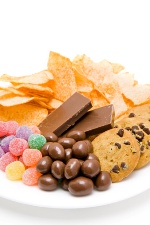 Drug addiction, alcohol addiction, sex addiction, shopping addiction, work addiction …the list goes on. We’ve heard about all of these forms of addictive behavior. And yet there’s one more very important addiction that is plaguing a large percentage of society that somehow doesn’t get talked about as much: food addiction.
Drug addiction, alcohol addiction, sex addiction, shopping addiction, work addiction …the list goes on. We’ve heard about all of these forms of addictive behavior. And yet there’s one more very important addiction that is plaguing a large percentage of society that somehow doesn’t get talked about as much: food addiction.
For a food addict, life can be hell. Food, one of the most basic, simple pleasures in life, becomes a battleground. Every meal is fraught with tests of willpower. Salty chips must be locked up, sweet and gooey chocolate brownies must be hidden away. For a food addict, even refusing to stock certain items in the kitchen is little help because once you step outside, there are countless reminders to indulge in addictive foods. Billboards urge people to bite, crunch, chew, slurp, and swallow all kinds of snack foods. Radio jingles haunt the airways with catchy reminders to purchase snacks. T.V. commercials show close-up photos of decadent, addictive foods.
All of this advertising, to put it bluntly, is meant to encourage us to overeat. The equation is simple: the more snack products that get sold, the more money food companies can make. These companies have invested hundreds of thousands of dollars to find out the secrets behind what keeps you coming back for more. They have mastered the laws of attraction when it comes to making certain foods desirable.
Big name food companies conduct studies to find exactly how much sugar, salt, or fat will keep you eating long after you’re full. For some, this artful balancing of additive ingredients leads to a full-on health disaster. The result? Guilt, shame, and chronic weight problems.
PLUS: How sugary drinks kill
The top snack producers use surprisingly sophisticated methods to create food addicts out of all of us. They study how food feels in your mouth, the pressure it takes to bite those food items, and the rate at which a specific food loses its “appeal as it is being eaten” (what the food scientists call “sensory specific satiety”).
Many snack foods are designed to sit right on the cusp of this threshold. Go too far with a taste—too salty, too sweet, and too fatty—and you’ll lose your desire to eat that food. But get the threshold just right and you’ll make your way through a whole box of a particular product. In fact, the entire process is so sophisticated that food scientists specifically design snacks that give an intense flavor when first bitten into, but then quickly dissipates. This is the beginning of addictive behavior. You want that little bit of pleasure that comes with biting into a snack food, so you reach for the next mouthful to repeat the sensation.
The “crunch” factor is also important. The louder the crunch, the more we perceive food to be fresh and tasty. Again, food scientists work long and hard to get the crunch just right. The rate at which food melts in the mouth can be very important when it comes to getting us to eat more than we should. According to the researchers, the quicker food dissolves in our mouths, the easier it is to trick the brain into thinking it hasn’t really consumed any calories.
The next time you find yourself reaching for that fifth handful of chips or cookies, remember that those foods have been designed to get you to overeat. To avoid the mental trauma that comes with food addiction, keep your body and mind calm with healthy, balanced food choices.
Source(s) for Today’s Article:
Crowe, K., “Food Cravings Engineered by Industry,” CBC News web site, March 7, 2013; http://www.cbc.ca/news/health/story/2013/03/05/f-vp-crowe-food-addiction.html, last accessed May 15, 2013.
Marlow, S., “Food Addiction: Could Overeating be Compulsive?” BBC News web site, April 29, 2013; http://www.bbc.co.uk/news/health-22336753, last accessed May 14, 2013.
